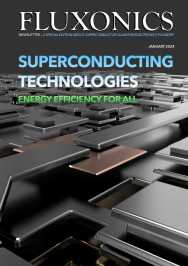Mission
FLUXONICS is a non-profit Society whose goal is to develop Superconductive Electronics in Europe and promote associated technological innovations through
Research, Training and Transfer of Knowledge.
FLUXONICS is composed of Laboratories from Universities, National Research Centers, and Private Companies.
The main activity of FLUXONICS currently deals with Superconductive Digital Electronics (SDE). But, since SDE needs to closely interact with the external
world, specific interfaces with semiconductors, optical systems and cryogenic systems are developed in the same framework by some of the FLUXONICS members, along with analog-to-digital and
digital-to-analog converters. Superconducting sensors are also considered: they share the same technologies as SDE, closely interact with it, and are of particular importance in different areas of
Science and Society. At last, some work is dedicated to materials studies and new developments, that are necessary to prepare the next generations of superconducting devices.
Since superconductors have been discovered in 1911 by Kammerlingh Onnes, a wide range of very exciting research has been conducted to understand their unique
properties. It has led to a broad range of unexpected applications of superconductors in various fields, ranging from Metrology with the voltage standard, to Medicine with magneto- cardiography or
encephalography. One can also mention ultra-high sensitivity sensors for Astrophysics or Geophysics, among many other applications. One important field for which superconductors present unique and
unsurpassed features is called Superconductive Electronics. This field can be divided in three parts:
- Superconductive Digital Electronics (SDE), which is based on the generation, propagation and processing of quanta of magnetic flux, called fluxons. With SDE, the digital bit ("0" or "1") is carried with fluxons, whose value is quantized. This quantization allows to perform some functions which are very difficult to achieve with traditional Electronics based on Semiconductors. Moreover, the clock frequency of superconductive digital circuits can reach several tens to several hundreds of GHz, with a very low consumption, due to the zero resistance of superconductors.
- Superconductive sensors which are used on everyday basis in Medicine, Astrophysics, Geophysics or in low-temperature Physics, due to their unsurpassed sensitivity. Among them, Superconducting Quantum Interference Devices (SQUIDs) are used in several applications as, for instance, magnetometers, amplifiers or for inductance diagnostic purposes.
- Microwave devices, like filters that present high quality factors, as well as low-loss transmission lines that are necessary to propagate signals between superconducting or semiconducting active devices. Active microwave devices include SIS mixers, Hot Electron Bolometers or Long Josephson Junctions used as microwave oscillators, as a few examples.
FLUXONICS was supported by the European FP7 project S-PULSE



